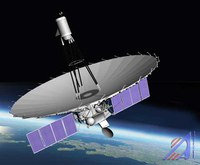Earth–space interferometry with RadioAstron
 Earth–space interferometry with RadioAstron provides the highest direct angular resolution ever achieved in astronomy at any wavelength. RadioAstron detections of the classic quasar 3C 273 on interferometric baselines up to 171,000 km suggest brightness temperatures exceeding expected limits from the inverse-Compton catastrophe by two orders-of-magnitude. The authors show that at 18 cm, these estimates most likely arise from refractive substructure introduced by scattering in the interstellar medium. They use the scattering properties to estimate an intrinsic brightness temperature of 7 x 1012 K, which is consistent with expected theoretical limits, but which is ~15x lower than estimates that neglect substructure. At 6.2 cm, the substructure influences the measured values appreciably but gives an estimated brightness temperature that is comparable to models that do not account for the substructure. At 1.35 cm, the substructure does not affect the extremely high inferred brightness temperatures, in excess of 1013 K. The authors also demonstrate that for a source having a Gaussian surface brightness profile, a single long-baseline estimate of refractive substructure determines an absolute minimum brightness temperature, if the scattering properties along a given line of sight are known, and that this minimum accurately approximates the apparent brightness temperature over a wide range of total flux densities.
Earth–space interferometry with RadioAstron provides the highest direct angular resolution ever achieved in astronomy at any wavelength. RadioAstron detections of the classic quasar 3C 273 on interferometric baselines up to 171,000 km suggest brightness temperatures exceeding expected limits from the inverse-Compton catastrophe by two orders-of-magnitude. The authors show that at 18 cm, these estimates most likely arise from refractive substructure introduced by scattering in the interstellar medium. They use the scattering properties to estimate an intrinsic brightness temperature of 7 x 1012 K, which is consistent with expected theoretical limits, but which is ~15x lower than estimates that neglect substructure. At 6.2 cm, the substructure influences the measured values appreciably but gives an estimated brightness temperature that is comparable to models that do not account for the substructure. At 1.35 cm, the substructure does not affect the extremely high inferred brightness temperatures, in excess of 1013 K. The authors also demonstrate that for a source having a Gaussian surface brightness profile, a single long-baseline estimate of refractive substructure determines an absolute minimum brightness temperature, if the scattering properties along a given line of sight are known, and that this minimum accurately approximates the apparent brightness temperature over a wide range of total flux densities.
Image: Artist rendering of the orbiting RadioAstron satellite, the farthest element in an array of radio antennas that combine to form the highest resolution instrument in all of astronomy. Credit: Lavochkin Association.
Science Team: Michael D. Johnson (CfA), Yuri Y. Kovalev (Lebedev, MPIfR), Carl R. Gwinn (UC-Santa Barbara), Leonid I. Gurvits (VLBI ERIC, Delft), Ramesh Narayan (CfA), Jean-Pierre Macquart (ICRAR, CAASTRO), David L. Jauncey (CSIRO, ANU), Peter A. Voitsik (Lebedev), James M. Anderson (Helmholtz-Zentrum), Kirill V. Sokolovsky (Lebedev, Moscow State), and Mikhail M. Lisakov (Lebedev).
Publication: Extreme Brightness Temperatures and Refractive Substructure in 3C273 with RadioAstron, 2016, Astrophysical Journal Letters, 820, L10.




Connect with NRAO